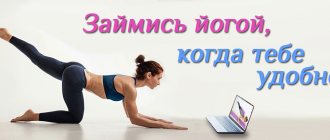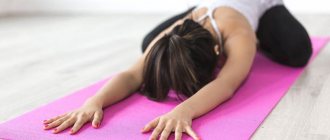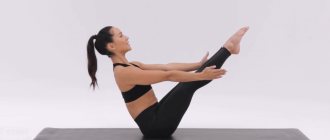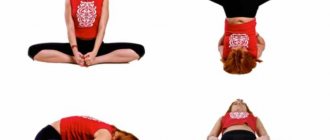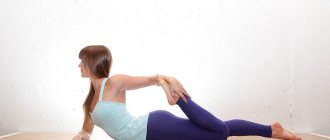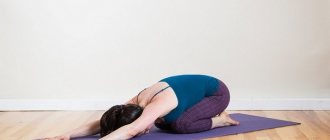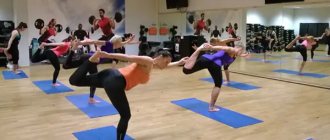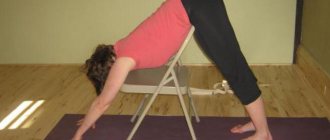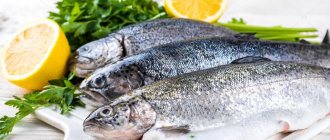The fish pose in yoga is performed with a delicate backbend, so it is recommended to do it after a series of inverted poses, as well as exercises such as Paschimottanasana (forward bending from a sitting position) and Janu Sirsasana (bending the head to the knee).
In Sanskrit, "matsya" means "fish". "Asana" is translated as "body position" or "posture". Matsiasana is called fish pose because the position of the legs in it is similar to the tail of a fish. The body and head resemble a fish body. There is another variant of the name: it is believed that it is convenient to be in the water. When changing the position of the legs and energy flows, the point of application of gravity shifts. The body is more correctly grouped, which allows you to swim without unnecessary stress.
Execution technique
- While in Padmasana, place straight arms behind the buttocks with palms on the floor, exhale, lean back, knees can be raised from the floor until the body is on the elbows.
- Inhale, open your chest and shoulders, straighten your back. Tilt your head back towards the floor.
- Inhale and carefully move your elbows in different directions until your head touches the floor, then lower your knees to the mat.
- Bend your back, transfer your body weight to your palms, raise your shoulders and back. Your knees are firmly on the floor.
- In this asana, the head should be pressed to the floor.
- Hold your feet with your hands and bend your back as much as possible so that there is no pain.
- The eyes look back. Hold the asana for 1-3 minutes.
- Exit from the pose: First, take a deep breath, then while exhaling, place your forearms on the floor, inhale again, using your hands to raise your head and torso vertically to the floor.
- Take the starting position and take a deep breath. Exhale and relax as much as possible with your eyes closed. Breathing should be uniform. If you still have strength after doing this, you can repeat the exercise.
Important! If you feel dizzy while performing this pose, you should do everything more slowly.
Matsyasana - benefits
The fish pose stretches the intestines and abdominal organs, which is beneficial for eliminating diseases in this area. To treat constipation, drink 3 glasses of water before performing this pose.
It brings relief from inflammation and bleeding of hemorrhoids.
The practice of Matsyasana is good for asthma and bronchitis, because... it creates conditions for deep breathing. It eliminates blood stagnation and back pain, helps with cervical spondylitis.
Asana regulates the function of the thyroid gland and stimulates the thymus gland, thereby improving immunity.
The pelvic area is well stretched, and the pressure of the legs on the hips reduces blood circulation in the legs, “redirecting” its flow to the pelvic organs, which prevents and treats diseases of the reproductive system.
If Shitkari pranayama is practiced in the final position of Matsyasana, it can make your voice “sweet” and smooth, and also eliminates sore throat and tonsillitis.
As a result of regular practice, the body is rejuvenated and filled with vitality.
Important note: when entering and exiting the final position, be sure to help yourself with your hands: movements of the back and neck must be under control so as not to damage the spine.
Light versions for beginners
Lightweight version with straight legs
If you can’t do the difficult version yet, there are a couple of easier variations of this pose:
- sit in the Lotus. If this does not work out yet, then you can do Matsiasana while in Vajrasana, connecting your knees and pressing them to the floor, or in Sukhasana;
- if you can’t bend over in Padmasana, then you need to lie on your back, straighten your arms behind your head, stretch with them, stretching the spine;
- The easiest option , which even beginners can do: sit on the floor with your legs straight, pointing your toes towards you. Bend back until your elbows touch the floor, slightly supporting your buttocks with your hands. Open your chest, stretch it up and forward, move your shoulders back. Tilt your head back until it touches the floor, without putting your body weight on it. Hold the asana for 30-60 seconds, then return back.
Complicated version with hands behind head
For those who are ready for a more complex implementation, there is this option:
- take Matsiasana, straighten your arms behind your head, turning your palms towards each other, stretch, opening your chest, interlace your elbows and lower them to the floor behind your head;
- perform the variation described above, only without relying on your forearms when entering and exiting it.
As preparation, it is recommended to perform the following poses:
- butterflies (Baddha Konasana);
- cobras (Bhujangasana);
- bow (Dhanurasana);
- locusts (Salabhasana);
- half bridge (Setu Bandha Sarvangasana);
- upward facing dogs (Urdhva Mukha Svanasana);
- hero (Virasan).
Harm of exercise
When there are benefits, there are also contraindications. It cannot be said that there is any harm from the yoga pose, unless you overdo it by folding your legs sharply into the lotus position. Or you will start to turn your head during the exercise and damage your cervical vertebrae (and this, of course, is possible if you do not follow safety precautions!)
If we talk about contraindications, then it should not be done:
- if you have recently eaten heavily, the asana may cause nausea
- if there are problems with the vestibular system, it can cause dizziness
- with hyperfunction of the thyroid gland, so as not to stimulate it again
- if you have an intervertebral hernia in the thoracic and cervical region
- if you have high or low blood pressure, you will simply feel uncomfortable doing it. If you have high blood pressure, your nose may bleed; it is better to take care of yourself.
show more
In any case, if you feel discomfort and dizziness when performing the fish pose, it is better to stop performing the asana; your body itself will tell you if something does not suit you.
“Matsiasana is not recommended for hyperfunction of the thyroid gland, neck and lower back injuries” - Maria Krylova, yoga trainer .
Safety precautions when performing fish pose:
- feel your body, do not make sudden movements while performing the pose, do not try to put your legs in padmasana if it is not yet available to you in the usual position, take care of your knees. If you do a simple pose with legs extended, the effectiveness will not be worse
- do not turn your head while performing the asana.
- Having finished performing the fish pose, first lower your chest to the mat, and then change the position or rise, this will protect yourself from unnecessary injuries and sprains.
Benefit
Variant made from Vajrasana
Legendary meditation course without payment We recommend! The most popular meditation course for beginners in Russian. More than 100 thousand people have already learned to meditate. Try it yourself. Read more.
This asana stimulates the thyroid and parathyroid glands, as well as the entire endocrine system. Has a positive effect on the kidneys and adrenal glands.
It makes the muscles of the abdominal region, chest and larynx more relaxed, liberates the hips, helps strengthen the muscles of the upper back, cervical and shoulder region, and increases lung capacity.
Reference! Matsiasana distributes energy along the front surface of the body, stimulating the chakras: Manipura, Anahata and Vishuddha.
Beneficial effect
Experienced yogis advise people suffering from bronchial asthma and abdominal diseases to perform the fish pose. In addition, it is useful for postural disorders. This exercise has a number of useful benefits:
- Relaxation of the muscles of the whole body. Relieves tension after a hard day at work.
- Correction of postural disorders during systematic exercises.
- Activation of the thyroid gland.
- Distribution of energy throughout the upper body.
- Strengthening the muscles of the back, arms, chest, neck.
Due to the opening of the chest, deep ventilation of the lungs occurs. Their volume increases. In addition, it is useful to perform fish pose for frequent constipation and hemorrhoids.
The person relaxes and becomes more stress-resistant. His mood improves and he has the strength to reach new heights. With systematic exercise, the head becomes softer and calmer.
Contraindications
It is better to refuse to perform the asana if you have the following problems:
- hyperthyroidism;
- diseases and injuries associated with the spine, especially the cervical spine;
- knee joint injuries;
- high or low blood pressure;
- attacks of headache;
- insomnia.
If you find an error, please select a piece of text and press Ctrl+Enter.
Matsyasana: variations of fish pose
Option 1
The pose is performed in the same way as usual, except for the hands. The fingers are intertwined and placed behind the head, so the back of the head rests on the palms.
Option 2 (suitable for beginners)
Sit on the floor and stretch your legs forward. Bend one leg and place your foot on the thigh of the opposite leg (for example, right foot on left thigh, see photo). You will get a position like in a half-lotus (Ardha Padmasana). So, one leg is extended forward, the other is bent, and rests on the outstretched thigh.
Slowly lean back, helping yourself with your elbows, and lower your crown to the floor. With both hands, grab the foot of your bent leg. Arch your back as much as possible, but don't overexert yourself.
Relax your whole body and close your eyes. This is the final position in which you can remain as long as it is comfortable before returning to a sitting position. Repeat the pose with the other leg. If it is difficult to place the crown of your head on the floor, you can place the back of your head (although it may be more difficult with the back arched).
Option 3 (also for beginners)
Sit on the floor with your legs extended forward. Lean back, helping yourself with your elbows, and place your crown on the floor. Arch your back, place your palms on your hips or on the floor, along your body. After some time, return to the starting position.
The benefits and nuances of complex yoga asanas
It is worth mastering complex asanas (for example, hand balances) not so much for aesthetic purposes, but to improve health and improve concentration.
Why? By regularly performing these poses, you will “pump up” the basic parameters of the body: improve flexibility, strengthen muscles and joint function (open the hips, for example). Some similar poses affect the functioning of internal organs (for example, Mayurasana stimulates the liver and gastrointestinal tract). The opposite is also true: to more quickly master complex asanas, you need certain preparation (i.e. having sufficiently strong arms, back, abs). “These asanas are multi-level, multifaceted,” explains Artem Chernyshov, yoga teacher, founder of the YogaMind studio in Polyanka . “In such balance asanas, you need not only strong arms and shoulders, you need to be able to twist, you need good stretching of the legs, the vestibular system, strong abdominal muscles, strong and strong palms.”
That is, if you came to yoga for the first time yesterday (and have never done any sports before), you should not master hand balances tomorrow. “If we have weak back muscles or arm muscles, these asanas are simply impossible to perform,” warns Artem Chernyshov. Have you been practicing for at least a year, have you managed to slightly strengthen the muscles of your arms, abs and back? You can gradually include complex asanas in your classes.
Description of Marjariasana
In marjariasana, the spinal column is located horizontally, in a position of axial unloading; pressure is relieved from the intervertebral discs. At the same time, it remains possible to gently and safely work with the spinal column in different planes, involving the paravertebral muscles, ligamentous and articular apparatus of the spine in the process of movement.
The elements used in the marjariasana position are quite diverse and are capable of providing almost the full range of physiological movements of the vertebrae relative to each other: flexion (flexion), extension (extension), rotation (twisting the vertebrae relative to each other), lateroflexion (lateral bending). Therefore, the marjariasana cycle is the cornerstone of any yoga therapy complex - both for spinal pathologies (primarily osteochondrosis and intervertebral hernias), and in the case of working with the elderly, beginners, patients with neurological, cardiological and other pathologies.
Most elements are executed dynamically. In this case, the inhalation is performed in a deflection position - that is, with contraction of the erector spinae muscles, interspinous muscles and others that reduce the distance between the sacrum and the back of the head; movement is usually accompanied by a decrease in thoracic kyphosis and an increase in lumbar lordosis. On exhalation, stretching of the mentioned muscle groups occurs, kyphosis of the lumbar region and an increase in thoracic kyphosis. To avoid hyperventilation, as well as to harmonize the basic physiological biorhythms, the natural rhythm of breathing is maintained, a spontaneous pause after exhalation is maintained, movement follows the breath (and not vice versa); Read more about this in the section “Principles of working with breathing in yoga therapy.”
The starting position for performing variations of majariasana is standing on all fours. Palms are shoulder-width apart, knees are hip-width apart. Each wrist is located under the shoulder joint, the knee under the hip joint. This variant of hand placement will be called “first position”. The “second position” option will be described below.
Indications
Matsiasana can provide effective help for postural disorders, bronchopulmonary diseases (from bronchitis and pneumonia to asthma and tuberculosis), for digestive disorders (in particular, constipation) to diseases of the abdominal organs.
Contraindications to performing Matsiasana are hyperthyroidism, hypertension and hypotension, diseases of the spine, especially the cervical spine, as well as injuries to the neck, knees and hips; sleep disorders, migraine.
Article on the topic: “Garuda mudra”
The most popular poses in yoga
Bhujangasana pose
Vajrasana (Diamond)
Virasana (Hero)
Baddha Konasana
Halasana (Plow)
What are the benefits for the body?
The beneficial effects of this asana affect not only the muscles and joints, but also the internal organ systems:
- the elasticity of the muscles of the abdomen, back, chest, shoulders, neck increases, spasmodic pain is eliminated;
- posture is straightened, stabilizer muscles are trained;
- the volume of the lungs increases, the chest opens, acute respiratory viral infections are eliminated and mucous masses leave the bronchi;
- blood circulation in the pelvic organs and gastrointestinal tract improves;
- the body's endurance increases, the functioning of the nervous system is stabilized;
- it has a stimulating effect on the functioning of the thyroid and pancreas glands, adrenal glands, and ovaries.
Features of Matsiasana
Matsya means fish in Sanskrit. This asana is described in the 15th century treatise “Hatha Yoga Pradipika” by guru Swami Swatmarama. According to one version, the pose has this name because of the similarity of the position of the legs with the tail of a fish. You can see this for yourself. According to another, it is easy to stay afloat in this position.
Bent legs shift the center of mass, and proper circulation of vital energy keeps the whole body on the water. The head will always be above the water in this position, the body will be more compactly grouped.
The asana can be performed after a series of stretching, twisting, and bending exercises. It is difficult because it requires good stretching and physical training.
In its full version, matsyasana is performed from padmasana, the lotus pose. In this article we will talk about the classic exercise technique, as well as lighter versions of the same pose.
